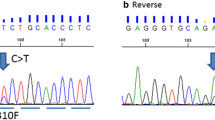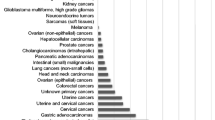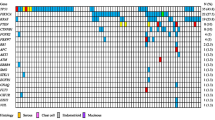Abstract
Background
Although overexpression, amplification, and somatic mutation of the HER2 gene have been noted in various types of human cancers, we report here for the first time that novel mutations and amplification of the HER2 gene occurred concomitantly in mucinous epithelial ovarian cancer (EOC).
Methods
Twenty-seven tissue microarray samples from EOC patients were analyzed by immunohistochemistry (IHC) with Dako c-erb-B2 antibody and subsequently were examined by fluorescence in situ hybridization (FISH) with the Abbott PathVysion HER2 DNA Probe Kit. HER2 gene, exon 18–24, encoding a tyrosine kinase domain, was analyzed by polymerase chain reaction (PCR) and direct sequencing.
Results
The FISH–IHC paired results confirmed 19 concordant negative results and 3 concordant positive results. Moreover, all 4 HER2-amplified cases were of the mucinous type, whereas the remaining 23 HER2-nonamplified cases were of the nonmucinous type. The 4 mucinous EOC cases with HER2 gene amplification were selected and further analyzed for HER2 gene mutations. Data revealed that somatic mutations were present in 2 cases (R970W and E971G), but absent in the other 2 cases.
Conclusions
HER2 protein overexpression correlated significantly with HER2 gene amplification in EOC (P = 0.027). It is surprising that all 4 cases of mucinous EOC showed HER2 gene amplification confirmed by FISH testing. However, we suppose that increasing the number of cases would possibly modify the results. This study also showed that both HER2 gene amplification and somatic mutations are not mutually exclusive in mucinous EOC. Further studies are warranted to investigate the potential role of anti-HER2 therapy.



Similar content being viewed by others
References
Hess V, A’Hern R, Nasiri N, et al. Mucinous epithelial ovarian cancer: a separate entity requiring specific treatment. J Clin Oncol. 2004;22:1040–4.
Hart WR, Mucinous tumors of the ovary: a review. Int J Gynecol Pathol. 2005;24:4–25.
Seidman JD, Kurman RJ, Ronnett BM. Primary and metastatic mucinous adenocarcinomas in the ovaries: incidence in routine practice with a new approach to improve intraoperative diagnosis. Am J Surg Pathol. 2003;27:985–93.
Kecmanovic DM, Pavlov MJ, Kovacevic PA, Ceranic MS, Stamenkovic AB. Cytoreductive surgery for ovarian cancer. Eur J Surg Oncol. 2003;29:315–20.
Neijt JP, Engelholm SA, Tuxen MK, et al. Exploratory phase III study of paclitaxel and cisplatin versus paclitaxel and carboplatin in advanced ovarian cancer. J Clin Oncol. 2000;18:3084–92.
Blagden S, Gabra H. Future directions in the management of epithelial ovarian cancer. Future Oncol. 2008;4:403–11.
Fujimura M, Katsumata N, Tsuda H, et al. HER2 is frequently over-expressed in ovarian clear cell adenocarcinoma: possible novel treatment modality using recombinant monoclonal antibody against HER2, trastuzumab. Jpn J Cancer Res. 2002;93:1250–7.
Pignata S, Ferrandina G, Scarfone G, et al. Activity of chemotherapy in mucinous ovarian cancer with a recurrence free interval of more than 6 months: results from the SOCRATES retrospective study. BMC Cancer. 2008;8:252.
Shimada M, Kigawa J, Ohishi Y, et al. Clinicopathological characteristics of mucinous adenocarcinoma of the ovary. Gynecol Oncol. 2009;113:331–4.
Auersperg N, Wong AS, Choi KC, Kang SK, Leung PC. Ovarian surface epithelium: biology, endocrinology, and pathology. Endocr Rev. 2001;22:255–88.
Cuadros M, Villegas R. Systematic review of HER2 breast cancer testing. Appl Immunohistochem Mol Morphol. 2009;17:1–7.
García-Velasco A, Mendiola C, Sánchez-Muñoz A, Ballestín C, Colomer R, Cortés-Funes H. Prognostic value of hormonal receptors, p53, ki67 and HER2/neu expression in epithelial ovarian carcinoma. Clin Transl Oncol. 2008;10:367–71.
Tai W, Mahato R, Cheng K. The role of HER2 in cancer therapy and targeted drug delivery. J Control Release. 2010;146:264–75.
Gong Y, Gilcrease M, Sneige N. Reliability of chromogenic in situ hybridization for detecting HER-2 gene status in breast cancer: comparison with fluorescence in situ hybridization and assessment of interobserver reproducibility. Mod Pathol. 2005;18:1015–21.
Wolff AC, Hammond ME, Schwartz JN, et al. American Society of Clinical Oncology; College of American Pathologists. American Society of Clinical Oncology/College of American Pathologists guideline recommendations for human epidermal growth factor receptor 2 testing in breast cancer. J Clin Oncol. 2007;25:118–45.
Lee JW, Soung YH, Kim SY, et al. ERBB2 kinase domain mutation in the lung squamous cell carcinoma. Cancer Lett. 2006;37:9–94.
Vermeij J, Teugels E, Bourgain C, et al. Genomic activation of the EGFR and HER2-neu genes in a significant proportion of invasive epithelial ovarian cancers. BMC Cancer. 2008;8:3.
Han CP, Hsu JD, Yao CC, et al. HER2 gene amplification in primary mucinous ovarian cancer: a potential therapeutic target. Histopathology. 2010;57:763–4.
Slamon DJ, Clark GM, Wong SG, Levin WJ, Ullrich A, McGuire WL. Human breast cancer: correlation of relapse and survival with amplification of the HER-2/neu oncogene. Science. 1987, 235:177–82.
Chávez-Blanco A, Pérez-Sánchez V, Gonzalez-Fierro, et al. HER2 expression in cervical cancer as a potential therapeutic target. BMC Cancer. 2004;4:59.
Cox G, Vyberg M, Melgaard B, Askaa J, Oster A, O’Byrne KJ. Herceptest: HER2 expression and gene amplification in non-small cell lung cancer. Int J Cancer. 2001 15;92:480–3.
Jørgensen JT. Targeted HER2 treatment in advanced gastric cancer. Oncology. 2010;78:26–33.
Hauser-Kronberger C, Peham K, Grall J, Rausch W, Hutarew G, Dietze O. Novel approach of human epidermal growth factor receptor 2 detection in noninvasive and invasive transitional cell carcinoma of the bladder. J Urol. 2006;175:875–80.
Serrano-Olvera A, Dueñas-González A, Gallardo-Rincón D, Candelaria M, De la Garza-Salazar J. Prognostic, predictive and therapeutic implications of HER2 in invasive epithelial ovarian cancer. Cancer Treat Rev. 2006;32:180–90.
Sato-Kuwabara Y, Neves JI, Fregnani JH, Sallum RA, Soares FA. Evaluation of gene amplification and protein expression of HER-2/neu in esophageal squamous cell carcinoma using fluorescence in situ hybridization (FISH) and immunohistochemistry. BMC Cancer. 2009;9:6.
Scholl S, Beuzeboc P, Pouillart P. Targeting HER2 in other tumor types. Ann Oncol. 2001;12(Suppl. 1):S81–7.
Shigematsu H, Takahashi T, Nomura M, et al. Somatic mutations of the HER2 kinase domain in lung adenocarcinomas. Cancer Res. 2005;65:1642–6.
Generali D, Leek R, Fox SB, et al. EGFR mutations in exons 18–21 in sporadic breast cancer. Ann Oncol. 2007;18:203–5.
Stephens P, Hunter C, Bignell G, et al. Lung cancer: intragenic ERBB2 kinase mutations in tumours. Nature. 2004;431:525–6.
Lassus H, Sihto H, Leminen A, et al. Gene amplification, mutation, and protein expression of EGFR and mutations of ERBB2 in serous ovarian carcinoma. J Mol Med. 2006;84:671–81.
Lee JW, Soung YH, Seo SH, et al. Somatic mutations of ERBB2 kinase domain in gastric, colorectal, and breast carcinomas. Clin Cancer Res. 2006;12:57–61.
Bekaii-Saab T, Williams N, Plass C, Calero MV, Eng C. A novel mutation in the tyrosine kinase domain of ERBB2 in hepatocellular carcinoma. BMC Cancer. 2006;6:278.
McAlpine JN, Wiegand KC, Vang R, Ronnett BM, Adamiak A, Köbel M. HER2 overexpression and amplification is present in a subset of ovarian mucinous carcinomas and can be targeted with trastuzumab therapy. BMC Cancer. 2009;9:433.
Lee ES, Lee Y, Suh D, Kang J, Kim I. Detection of HER-2 and EGFR gene amplification using chromogenic in-situ hybridization technique in ovarian tumors. Appl Immunohistochem Mol Morphol. 2010;18:69–74.
McCluggage WG. The value of immunohistochemistry as a diagnostic aid in ovarian neoplasia: a review. Pathology Case Reviews. 2006;11:31–7.
Yemelyanova AV, Vang R, Judson K, Wu LS, Ronnett BM. Distinction of primary and metastatic mucinous tumors involving the ovary: analysis of size and laterality data by primary site with reevaluation of an algorithm for tumor classification. Am J Surg Pathol. 2008;32:128–38.
Acknowledgment
This work was supported in parts by grants from Department of Health (DOH99-FDA-43002-H), Chung Shan Medical University (G098N0013) and Chung Shan Medical University Hospital (CSH-2010-C-016), Taiwan, ROC.
Author information
Authors and Affiliations
Corresponding author
Additional information
Epithelial ovarian cancer (EOC); Immunohistochemistry (IHC); Fluorescence in situ hybridization (FISH); Polymerase chain reaction (PCR); American Society of Clinical Oncology and the College of American Pathologists (ASCO-CAP)
Rights and permissions
About this article
Cite this article
Lin, WL., Kuo, WH., Chen, FL. et al. Identification of the Coexisting HER2 Gene Amplification and Novel Mutations in the HER2 Protein-Overexpressed Mucinous Epithelial Ovarian Cancer. Ann Surg Oncol 18, 2388–2394 (2011). https://doi.org/10.1245/s10434-011-1572-z
Received:
Published:
Issue Date:
DOI: https://doi.org/10.1245/s10434-011-1572-z




